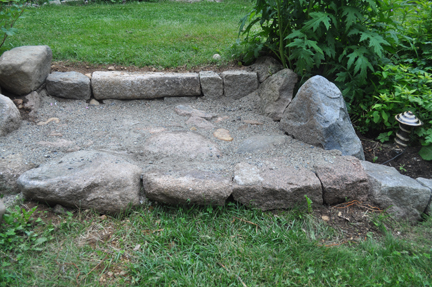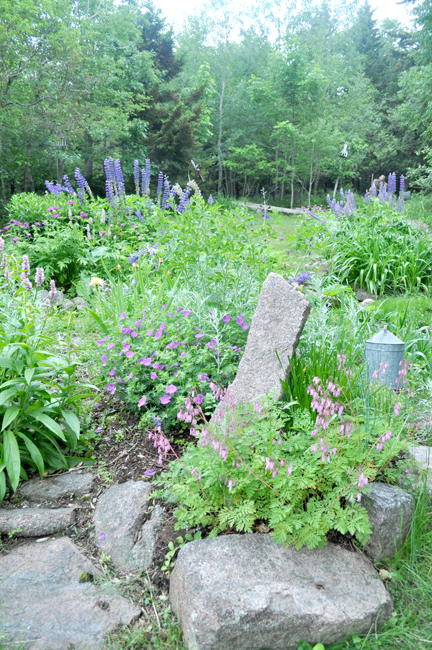
Granite chunks edge my gardens, the foundation of the house is granite fieldstone, I make paths with flat granite slabs, and whenever I dig into the back yard, I strike granite rubble. Scratch the surface anywhere on Mount Desert Island, and you will find granite.
Acadia National Park draws millions of visitors each year to climb its granite mountains and admire the steep rocky coast. Postcards feature warm pink granite edged by the white foam of the Atlantic. Frederic Church’s painting, Otter Creek, Mt. Desert, is of the cove behind my house and the granite notch I pass daily. In the mid-1800’s and early 1900’s granite was big industry on this island, and the first commercial quarry was here in the village of Otter Creek. Granite is the substance on which our lives are grounded.
I have been moving granite lately. Granite steps now separate the level grassy patch where the dining table is from the sloping hill to the woods. A crude wall has been built around the summer bedroom and constrains the pine needles strewn on the ground. I used crowbars and a dolly, and moved hundreds of pounds of rock. Each rock was touched, stroked and examined. The right shape and size was essential to fit the stones for the steps. One would be laid, and then another, and then an awkward space appeared. I removed them and tried again. Eventually, stone by stone, the puzzle was solved, and the steps created with a random pattern of about thirty pieces of granite.
Building with stone puts one in the moment. As I composed my steps, I would survey the collection of rocks I had hauled from throughout the yard and dumped in a pile. I appraised each one for the right fit. I would feel its edges, and ponder it from different angles. One wedge-shaped rock seemed too pointy, but rotated and inverted it was just right. Each rock when turned revealed different contours. I became mesmerized by the individual forms. There they were, odd shapes, sizes, and thicknesses. But which one would sit snug against the last rock I had placed? Just as I was convinced I’d have to go hunting for more rocks, that not one of them that would fit the next space, my perception would shift and with a satisfying sense of recognition a stone would stand out as right.
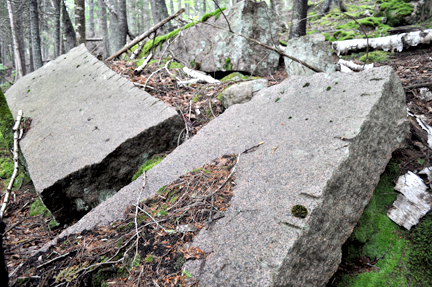
The grain and color seemed as varied as the shapes. It is, of course, all granite from Otter Creek, but not necessarily Otter Creek granite. A common rock, granite is a major part of our continental crust and is composed of quartz, feldspar, mica and other minerals. The color ranges from pink and gray to deep rose, blueish or almost black. The grain can be coarse with large individual pieces or so fine it appears to be almost all one color. It is color and grain that identifies granite. In Maine, Calais granite is dark gray and even-grained, the stone that came from the Thornberg Quarry in Addison is almost black, and Otter Creek granite is deep orange-red with a large, bold grain. The Maine Granite Industry Historical Society Museum in Mount Desert has a map of the island, with a piece of polished granite for each of the dozens of quarries on Mount Desert Island. Founder Steven Haynes can pick up a piece of stone, hold it in his hands, and by osmosis, bonding, knowledge and magic tell you which quarry it came from.
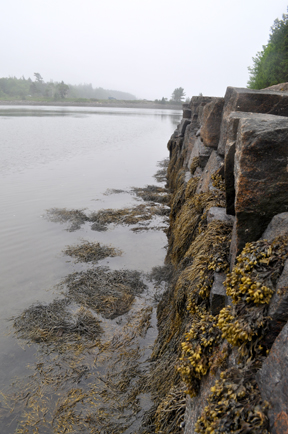
In the 1800’s quarrying in Otter Creek was a thriving industry. There were three different quarries in the village. The first was founded by Cyrus J. Hall in 1871 and operated about eight years. Roads were terraced into the hill and supported with granite coping stones. Oxen were used to transport the stone from where it was cut to a large granite wharf, the first product of this quarry. Jimmy’s Wharf is what it is called, although there is no sign, it is written on no maps, and no one seems to know who Jimmy was. At high tide a schooner would sail in to the wharf and load up. Four men, two oxen and a handful of tools produced eleven cargoes of stone. It was then shipped to Belfast where it was polished prior to delivery to its final destination. Some of those destinations were the Board of Trade building in Chicago, the American Baptist Publication Society building in Philadelphia and a bridge at Back Bay Fens in Boston, as well as libraries and public buildings. There is also a tantalizing mention in a local paper of fifty granite columns shipped to New York for a church. No other information given. How tall were those columns, what church do they grace, are they inside or out? Where are they now?
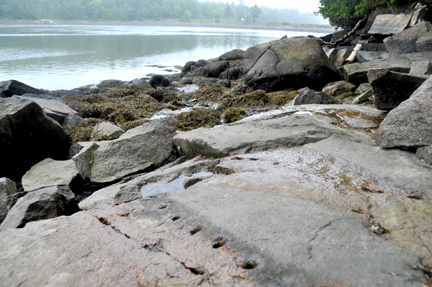
My husband’s great-great grandfather Jules lived in Otter Creek in the late eighteen hundreds within walking distance of the quarries. We wonder if he might have worked them, or helped build the roads. Whether he did or not, his great great grandson worked at the last producing quarry on the island. At nineteen years of age Dennis Smith worked for Joe Musetti in Hall Quarry and burnt rock with kerosene and compressed air to prepare the surface for the quarrymen to work. He was there only six weeks, during the last days of the quarry, as a small crew completed a contract and then shut the quarry down for good. With the introduction of Portland Cement the granite industry had come to an abrupt end.
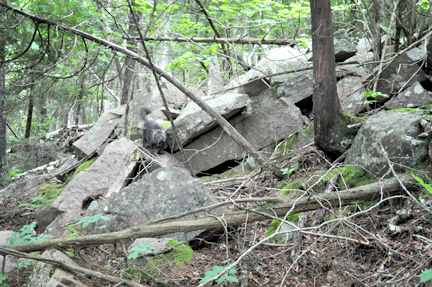
In Otter Creek, the stone wharf still stands, but has fallen into disrepair. A causeway has blocked the entrance where the large ships once entered the cove. Massive stone slabs with telltale wedge marks along one edge lie abandoned in the woods. We walk the roads, still clear but slowly narrowing, that had been built for those oxen to haul their heavy loads. And somewhere in New York City is a church with fifty granite columns from Otter Creek, Maine.

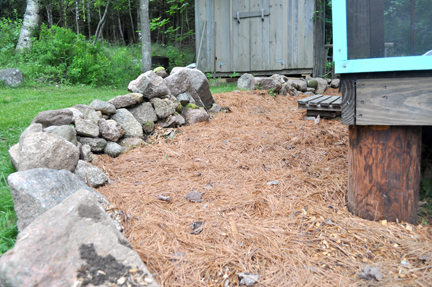
Nature Log: We gathered and ate the last of this season’s oyster mushrooms, watched a snapping turtle lay eggs, and lifted a piece of granite to reveal a garter snake. The stone was gently replaced.

